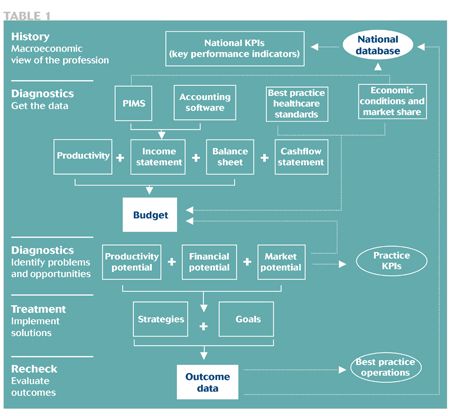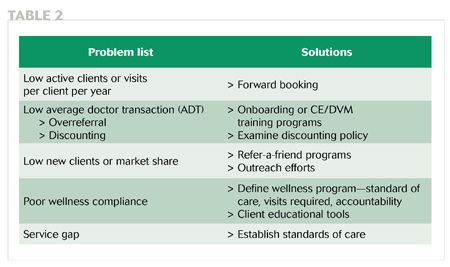Veterinarians: Will you continue to own your profession?
Unless veterinarians develop a financial focus, they may lose their position of influence in veterinary medicine.
Veterinarians are no longer the only ones influencing the values of the veterinary profession. In fact, veterinary medicine is undergoing a transformation that may impede their ability to care for patients the way they choose.
Historically, veterinarians have been at the center of all decisions affecting their profession, from educating future practitioners to developing animal-health-related public policy to determining standards of care. This wide scope of influence on the profession has had a single unified focus-animal health and welfare.
More recently, in response to a growing gap between the level of healthcare veterinarians say pets need (especially preventive care) and the amount of care pets actually receive, nonveterinarians have begun to acquire veterinary practices and focus on their financial performance, hoping to maximize the economic opportunities present in these hospitals.
In order for veterinarians to sustain their influence and authority in animal healthcare, they need to adopt a financial focus as well as a healthcare focus when it comes to their profession. And the best way to develop a financial focus is to embrace evidence-based practice management.
Evidence-based practice management
Evidence-based practice management approaches the financial health of a practice the same way evidence-based medicine approaches patient care. It all starts with good-quality information-AKA data. A practice has four primary sources of information, and these sources must be set up appropriately to maximize the quality of data received:
1. Practice management information system (PIMS). This system collects and reports data on production, revenue and inventory. It should be set up to complement the accounting software chart of accounts.
2. Accounting software. This system reports revenue, expenses, assets and liabilities in the form of financial statements (income statement, balance sheet, cash flow statement). A standardized chart of accounts can be downloaded from the American Animal Hospital Association (AAHA) website to properly set up accounting software.
3. Best-practice standards for pet wellness. A hospital's best practices for wellness care should be clearly defined. These standards should include the number of annual visits required to perform all necessary wellness services, when those services should be performed, the cost of those services and who should deliver those services.
4. Economic conditions and market share information. This data allows a practice to prepare for economic threats and seize market opportunities.
History: Take a macroeconomic view of the profession
A thorough history can provide critical information for making a diagnosis-information that can't be obtained through diagnostics alone. With evidence-based practice management, the “history” involves understanding the macroeconomics of the profession and examining key performance indicators (KPIs). This information can be found in veterinary market reports available on the American Veterinary Medical Association (AVMA) website that report on five financial KPIs to provide a national reference point for practices:
Total revenue
Total number of invoices
Cost of goods sold (COGS)
Cost of non-DVM labor
Cost of DVM labor.
See Table 1 for a visual map of how this process looks in practice.

Diagnostics: Get the data
Once you have your history, the next step is to run diagnostics on your practice. This means obtaining data from your PIMS and accounting software to create financial statements and obtain the five financial KPIs discussed above as well as five additional productivity KPIs:
Average doctor revenue
Average doctor transaction
Total active clients
Total new clients
Visits per client per year.
These numbers will represent an initial picture of your practice health as it pertains to current financial performance, productivity, wellness care guidelines, compliance with those wellness guidelines, and client culture.
The next step is to create an annual budget for your practice. This starts with last year's income statement. Adjust the revenue and expense portions of the budget based on projected changes to wellness best practices, economic conditions (growth or recession) and potential market share growth.
Diagnosis: Identify problems and opportunities
Analyze your financial statements and KPIs to diagnose problems affecting the financial health of your practice. You may also discover opportunities related to productivity, financial performance and market share.
Treatment: Implement solutions
Develop strategies for implementing solutions (see Table 2 for examples) and link the potential outcomes to your budget. Make sure each solution is measurable and designate a person to be accountable for implementation.

Recheck: Evaluate outcomes
As with any treatment, a recheck is essential for assessing the effectiveness of practice performance solutions. Determine whether each solution has reached its marker of success and decide if the treatment plan needs to be modified or discontinued.
Opportunities for improving financial literacy
The AVMA offers an intensive practice management CE track at the AVMA Convention in July and select state veterinary medical association meetings. The two-day course walks both practice owner and practice manager through the components of evidence-based practice management, including strategies for improving practice financial performance by closing the gap between the care pets need and the care they receive.
Combining a focus on financial performance with a focus on appropriate healthcare will improve a practice's economic health. And a healthy practice perpetuates a healthy profession by keeping veterinarians at the center of animal health and welfare.
Dr. Melissa Maddux is a research fellow in the AVMA's Veterinary Economics Division. Dr. Michael Dicks is director of the Veterinary Economics Division.